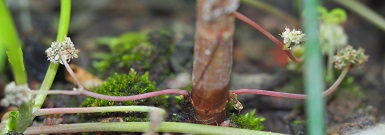| Home | Nature Weekly Index |
1 November 2020 | Hawaii Woodnettle | Laportea interrupta |
 On 21 June, I found an unknown seedling in my pot that turned out to be a
Laportea interrupta (Hawaii Woodnettle). It was
discovered when I was clearing other plant seedlings in the pot. All of them were familiar faces except this
one. It did not look like any of the plants that populated my potted area. In fact, this was the first time that
I had this plant in my pot. I had seen the plant in the wild in rare occasions but had yet to closely examine
it. Therefore, I decided to transfer it to a new pot. It did quite at first and started producing long stalks
from leaf axils that bear flowers and fruits. Soon, I observed yellowing of the leaves and most of them started
falling off. Upon close examination, it was clear that they were being attack by spider mites. I did not take
any action since I had already taken the plant pictures that I needed and its seeds had already littered the
soil. I could always get another new plant in the future from the fallen seeds.
On 21 June, I found an unknown seedling in my pot that turned out to be a
Laportea interrupta (Hawaii Woodnettle). It was
discovered when I was clearing other plant seedlings in the pot. All of them were familiar faces except this
one. It did not look like any of the plants that populated my potted area. In fact, this was the first time that
I had this plant in my pot. I had seen the plant in the wild in rare occasions but had yet to closely examine
it. Therefore, I decided to transfer it to a new pot. It did quite at first and started producing long stalks
from leaf axils that bear flowers and fruits. Soon, I observed yellowing of the leaves and most of them started
falling off. Upon close examination, it was clear that they were being attack by spider mites. I did not take
any action since I had already taken the plant pictures that I needed and its seeds had already littered the
soil. I could always get another new plant in the future from the fallen seeds.
 Spider mites are not new to my potted area. Their favourite plant is the
Blue Pea Vine (Clitoria ternatea). As a result, I had to
trim this vine once in a few months to remove all the leaves. It also got onto
my rose plants back in 2016.
Spider mites are not new to my potted area. Their favourite plant is the
Blue Pea Vine (Clitoria ternatea). As a result, I had to
trim this vine once in a few months to remove all the leaves. It also got onto
my rose plants back in 2016.
Hawaii Woodnettle has stinging hairs all over the plant. These hairs had been reported to cause skin irritation, swelling, intense itching. One article described it as a “highly poisonous plant” [1] but this description may be over exaggerated. Brushing your skin over the plant may cause a stinging effect but not potent enough to kill a person. I had not come across any report on fatality caused by the plant. On the other hand, Hawaii Woodnettle is a medicinal plant in India [2, 3] and the Philippines [4]. The common name Stinging Nettle is often referred to Urtica dioica while the name Wood Nettle is usually referred to Laportea canadensis.
 An article published in 2016 described a new species in the Laportea genus found in India known as
Laportea stolonifera. One of the distinctions between this new species and Hawaii Woodnettle was the
presence of 2 to 3 stolons arising from basal nodes of the stem that bear inflorescence [5]. Stolons are stems
that grow in parallel along the soil surface. This description caught my attention because the plant in my pot
also had such feature.
An article published in 2016 described a new species in the Laportea genus found in India known as
Laportea stolonifera. One of the distinctions between this new species and Hawaii Woodnettle was the
presence of 2 to 3 stolons arising from basal nodes of the stem that bear inflorescence [5]. Stolons are stems
that grow in parallel along the soil surface. This description caught my attention because the plant in my pot
also had such feature.
The information on Laportea stolonifera was scarce, likely because it was a new discovery. It was not recorded in the Plant List website but was registered in the Plants of the World Online website. Besides the first-discovery publication from India in 2016, there was no other report or online picture on this plant.
References:
[1] Kalpana B, Devilal R, Goud MS, Shekar BC, Sadasivaiah B, Rao NB. Laportea interrupta (L.) Chew (Urticaceae) – A new distributional record from Central Eastern Ghats, India. J Biol Rec 2016;e0092016:81-85. | Read article |
[2] Selvam NT, Surabhi K, Acharya M. Ethnomedicinal value of Laportea interrupta L. Chew: a review. Int J Pharma Sci Res (IJPSR) 2016;7(5);245-249. | Read article |
[3] Selvam NT, Surabhi K, Kumar VK, Deep V, Acharya M. Physico-chemical, phytochemical and spectroscopic characteristics of aqueous and methanolic extracts of Laportea interrupta L. Chew leaf. Int J Sci Res Sci Tech (IJSRST) 2016;2(3);309-314. | Read article |
[4] De Guzman JAS, Beltran RJL, Rubio R, Ramos GB. Potential of pre–gestational intake of Laportea interrupta L. (stinging nettle) leaf decoction as an aid for fetal–maternal health. Asian Pac J Repro 2015;4(2):85-90. | Read article |
[5] Bhellum BL, Singh B. A new species of Laportea Gaudich. (Urticaceae) from Himalaya, India. Bangladesh J Plant Taxon 2016;23(2):189-194. | Read article |